Martin Magris
Probabilistic Survival Analysis by Approximate Bayesian Inference of Neural Networks
Apr 12, 2024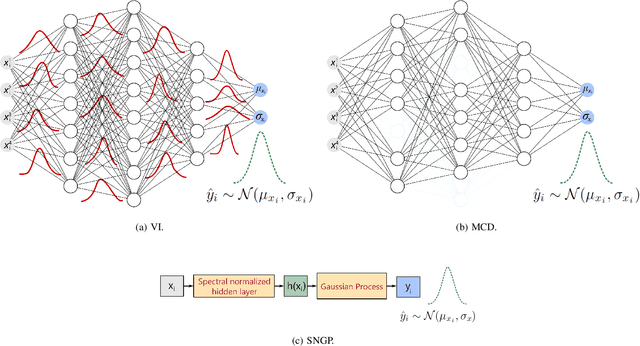
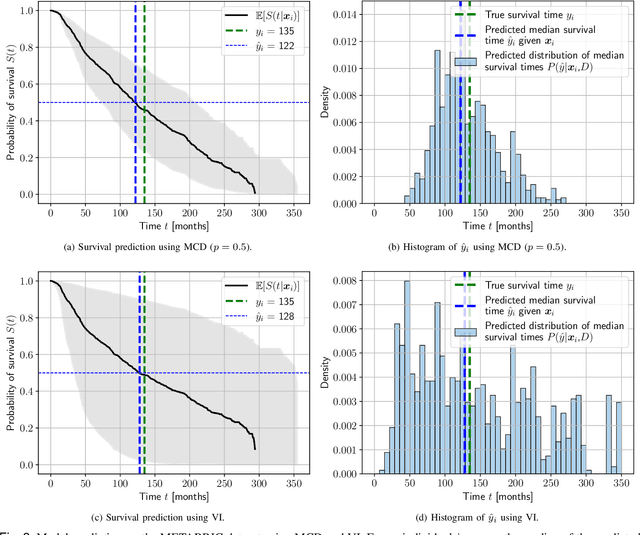

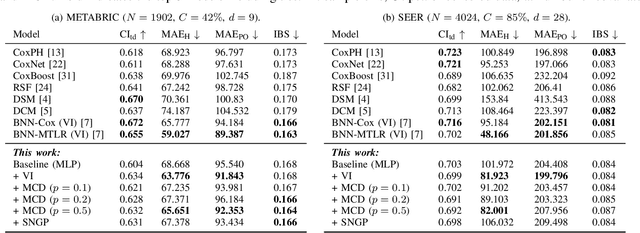
Abstract:Predicting future events always comes with uncertainty, but traditional non-probabilistic methods cannot distinguish certain from uncertain predictions. In survival analysis, probabilistic methods applied to state-of-the-art solutions in the healthcare and biomedical field are still novel, and their implications have not been fully evaluated. In this paper, we study the benefits of modeling uncertainty in deep neural networks for survival analysis with a focus on prediction and calibration performance. For this, we present a Bayesian deep learning framework that consists of three probabilistic network architectures, which we train by optimizing the Cox partial likelihood and combining input-dependent aleatoric uncertainty together with epistemic uncertainty. This enables us to provide uncertainty estimates as credible intervals when predicting the survival curve or as a probability density function over the predicted median survival times. For our empirical analyses, we evaluated our proposed method on four benchmark datasets and found that our method demonstrates prediction performance comparable to the state-of-the-art based on the concordance index and outperforms all other Cox-based approaches in terms of the mean absolute error. Our work explicitly compares the extent to which different Bayesian approximation techniques differ from each other and improves the prediction over traditional non-probabilistic alternatives.
Variational Inference for GARCH-family Models
Oct 05, 2023Abstract:The Bayesian estimation of GARCH-family models has been typically addressed through Monte Carlo sampling. Variational Inference is gaining popularity and attention as a robust approach for Bayesian inference in complex machine learning models; however, its adoption in econometrics and finance is limited. This paper discusses the extent to which Variational Inference constitutes a reliable and feasible alternative to Monte Carlo sampling for Bayesian inference in GARCH-like models. Through a large-scale experiment involving the constituents of the S&P 500 index, several Variational Inference optimizers, a variety of volatility models, and a case study, we show that Variational Inference is an attractive, remarkably well-calibrated, and competitive method for Bayesian learning.
Bayesian Learning for Neural Networks: an algorithmic survey
Nov 24, 2022Abstract:The last decade witnessed a growing interest in Bayesian learning. Yet, the technicality of the topic and the multitude of ingredients involved therein, besides the complexity of turning theory into practical implementations, limit the use of the Bayesian learning paradigm, preventing its widespread adoption across different fields and applications. This self-contained survey engages and introduces readers to the principles and algorithms of Bayesian Learning for Neural Networks. It provides an introduction to the topic from an accessible, practical-algorithmic perspective. Upon providing a general introduction to Bayesian Neural Networks, we discuss and present both standard and recent approaches for Bayesian inference, with an emphasis on solutions relying on Variational Inference and the use of Natural gradients. We also discuss the use of manifold optimization as a state-of-the-art approach to Bayesian learning. We examine the characteristic properties of all the discussed methods, and provide pseudo-codes for their implementation, paying attention to practical aspects, such as the computation of the gradients
Predicting the State of Synchronization of Financial Time Series using Cross Recurrence Plots
Nov 02, 2022Abstract:Cross-correlation analysis is a powerful tool for understanding the mutual dynamics of time series. This study introduces a new method for predicting the future state of synchronization of the dynamics of two financial time series. To this end, we use the cross-recurrence plot analysis as a nonlinear method for quantifying the multidimensional coupling in the time domain of two time series and for determining their state of synchronization. We adopt a deep learning framework for methodologically addressing the prediction of the synchronization state based on features extracted from dynamically sub-sampled cross-recurrence plots. We provide extensive experiments on several stocks, major constituents of the S\&P100 index, to empirically validate our approach. We find that the task of predicting the state of synchronization of two time series is in general rather difficult, but for certain pairs of stocks attainable with very satisfactory performance.
Exact Manifold Gaussian Variational Bayes
Oct 26, 2022Abstract:We propose an optimization algorithm for Variational Inference (VI) in complex models. Our approach relies on natural gradient updates where the variational space is a Riemann manifold. We develop an efficient algorithm for Gaussian Variational Inference that implicitly satisfies the positive definite constraint on the variational covariance matrix. Our Exact manifold Gaussian Variational Bayes (EMGVB) provides exact but simple update rules and is straightforward to implement. Due to its black-box nature, EMGVB stands as a ready-to-use solution for VI in complex models. Over five datasets, we empirically validate our feasible approach on different statistical, econometric, and deep learning models, discussing its performance with respect to baseline methods.
Quasi Black-Box Variational Inference with Natural Gradients for Bayesian Learning
May 23, 2022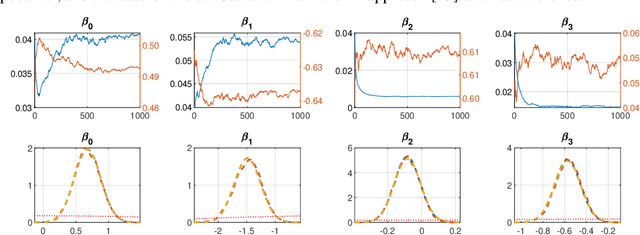
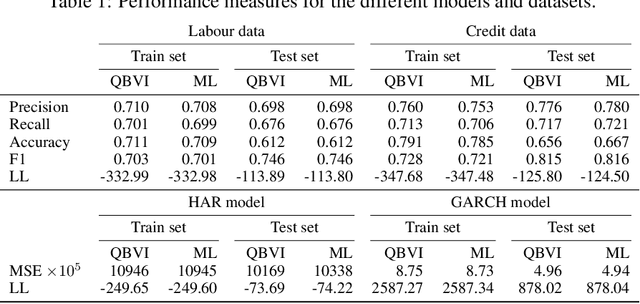


Abstract:We develop an optimization algorithm suitable for Bayesian learning in complex models. Our approach relies on natural gradient updates within a general black-box framework for efficient training with limited model-specific derivations. It applies within the class of exponential-family variational posterior distributions, for which we extensively discuss the Gaussian case for which the updates have a rather simple form. Our Quasi Black-box Variational Inference (QBVI) framework is readily applicable to a wide class of Bayesian inference problems and is of simple implementation as the updates of the variational posterior do not involve gradients with respect to the model parameters, nor the prescription of the Fisher information matrix. We develop QBVI under different hypotheses for the posterior covariance matrix, discuss details about its robust and feasible implementation, and provide a number of real-world applications to demonstrate its effectiveness.
Bayesian Bilinear Neural Network for Predicting the Mid-price Dynamics in Limit-Order Book Markets
Mar 07, 2022
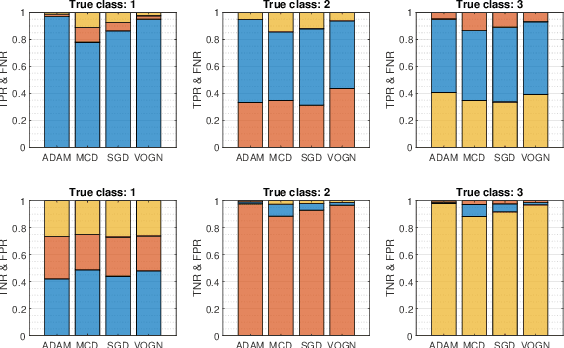
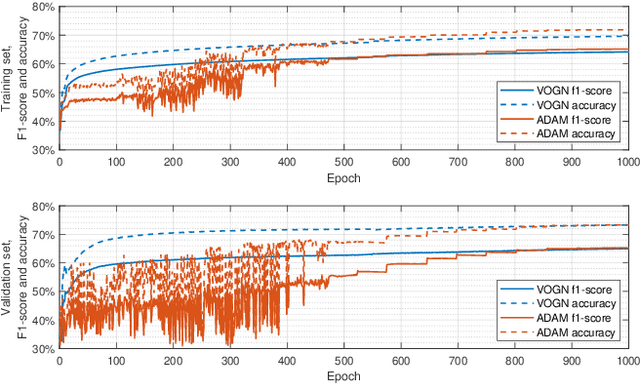
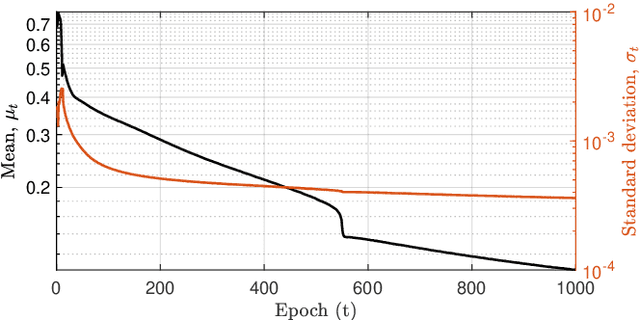
Abstract:The prediction of financial markets is a challenging yet important task. In modern electronically-driven markets traditional time-series econometric methods often appear incapable of capturing the true complexity of the multi-level interactions driving the price dynamics. While recent research has established the effectiveness of traditional machine learning (ML) models in financial applications, their intrinsic inability in dealing with uncertainties, which is a great concern in econometrics research and real business applications, constitutes a major drawback. Bayesian methods naturally appear as a suitable remedy conveying the predictive ability of ML methods with the probabilistically-oriented practice of econometric research. By adopting a state-of-the-art second-order optimization algorithm, we train a Bayesian bilinear neural network with temporal attention, suitable for the challenging time-series task of predicting mid-price movements in ultra-high-frequency limit-order book markets. By addressing the use of predictive distributions to analyze errors and uncertainties associated with the estimated parameters and model forecasts, we thoroughly compare our Bayesian model with traditional ML alternatives. Our results underline the feasibility of the Bayesian deep learning approach and its predictive and decisional advantages in complex econometric tasks, prompting future research in this direction.
Multi-head Temporal Attention-Augmented Bilinear Network for Financial time series prediction
Jan 14, 2022
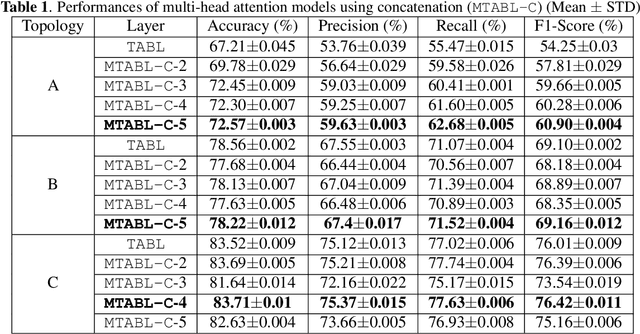
Abstract:Financial time-series forecasting is one of the most challenging domains in the field of time-series analysis. This is mostly due to the highly non-stationary and noisy nature of financial time-series data. With progressive efforts of the community to design specialized neural networks incorporating prior domain knowledge, many financial analysis and forecasting problems have been successfully tackled. The temporal attention mechanism is a neural layer design that recently gained popularity due to its ability to focus on important temporal events. In this paper, we propose a neural layer based on the ideas of temporal attention and multi-head attention to extend the capability of the underlying neural network in focusing simultaneously on multiple temporal instances. The effectiveness of our approach is validated using large-scale limit-order book market data to forecast the direction of mid-price movements. Our experiments show that the use of multi-head temporal attention modules leads to enhanced prediction performances compared to baseline models.
Tensor Representation in High-Frequency Financial Data for Price Change Prediction
Nov 28, 2017



Abstract:Nowadays, with the availability of massive amount of trade data collected, the dynamics of the financial markets pose both a challenge and an opportunity for high frequency traders. In order to take advantage of the rapid, subtle movement of assets in High Frequency Trading (HFT), an automatic algorithm to analyze and detect patterns of price change based on transaction records must be available. The multichannel, time-series representation of financial data naturally suggests tensor-based learning algorithms. In this work, we investigate the effectiveness of two multilinear methods for the mid-price prediction problem against other existing methods. The experiments in a large scale dataset which contains more than 4 millions limit orders show that by utilizing tensor representation, multilinear models outperform vector-based approaches and other competing ones.
* accepted in SSCI 2017, typos fixed
 Add to Chrome
Add to Chrome Add to Firefox
Add to Firefox Add to Edge
Add to Edge